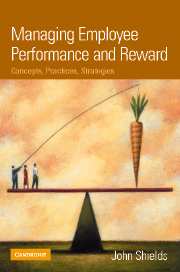Book contents
- Frontmatter
- Contents
- List of figures and tables
- Foreword by John Egan
- Acknowledgements
- Introduction: Setting the scene
- Part 1 The fundamentals
- Part 2 Performance management in action
- Part 3 Base pay and benefits
- Part 4 Rewarding employee performance
- Part 5 Fitting it all together
- Model responses to case studies
- References
- Index
Model responses to case studies
- Frontmatter
- Contents
- List of figures and tables
- Foreword by John Egan
- Acknowledgements
- Introduction: Setting the scene
- Part 1 The fundamentals
- Part 2 Performance management in action
- Part 3 Base pay and benefits
- Part 4 Rewarding employee performance
- Part 5 Fitting it all together
- Model responses to case studies
- References
- Index
Summary
This appendix provides model responses to the challenges posed in each of the major case studies at the end of parts 2, 3 and 4. Once you have formulated your own responses, you may find it helpful to compare these with those offered here. Pay particular attention to points that you may have misunderstood or overlooked.
Part 2 Case study
Delivering fairness: Performance assessment at Mercury Couriers
The instrument is a generic assessment tool applied to all non-managerial positions in the firm and uses single-source (supervisory) assessment as well as ranking technique for an evaluative purpose. It does so in a low-involvement context where there is little employee ‘voice’.
The performance criteria used are best described as a combination of results (criteria 1 and 2: ‘quantity’ and ‘accuracy’), trait-related competencies (criteria 3, 5 and 6: ‘alertness’, ‘dependability’ and ‘mental flexibility’) and directly observable behaviour (criteria 4, 7 and 9: ‘respect and courtesy’ and ‘doing that which is apart from his/her own job’ – or organisational citizenship behaviour – and ‘attendance’ – or membership behaviour). There is also a summative assessment criterion (‘overall performance’).
The main measuring techniques used are Behaviourally Anchored Rating Scales (BARS) with a combination of positive and negative anchors (criteria 1–4 and 6). However, three of the criteria (5, 7 and 8) are measured by means of the Mixed Standards Scales (MSS) variant of the Graphic Rating Scale (GRS) technique.
- Type
- Chapter
- Information
- Managing Employee Performance and RewardConcepts, Practices, Strategies, pp. 540 - 554Publisher: Cambridge University PressPrint publication year: 2007



